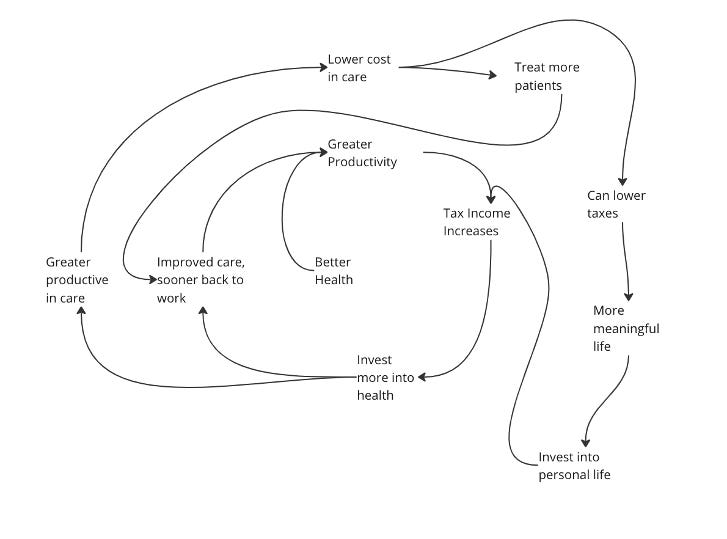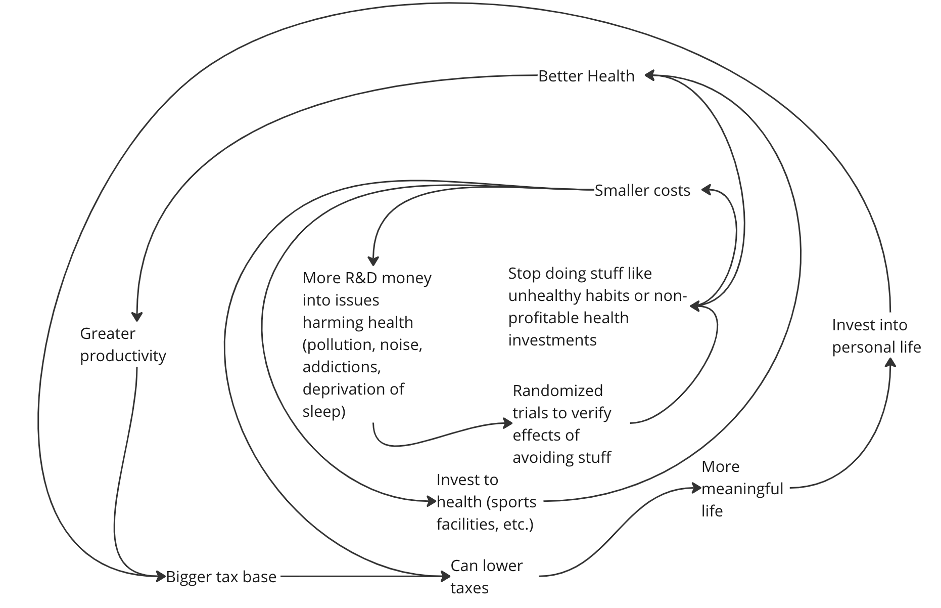Health Flywheels
Let’s break the regular programming for a while and return to the topic of health. Something we discussed in the post series starting here.
Active Health Flywheel
Flywheel concept became known to me first from the Amazon Flywheel that according to stories was first drawn on a napkin explaining how Amazon creates a virtuous self-enforcing circle of business growth by investing revenue back to improving its services.
Here my take an applying the concept to health.
Not the most beautiful image but you should see the drawings I made at school in art classes to appreciate how far I’ve progressed. Anyways, on with the program.
There are several self-enforcing loops where first health services increase people’s general health status so less treatments and medicines are needed, and people return back to work sooner. This increases the amount of output nationally (more products and services are produced) which in turn increases tax income. This in turn allows to invest into R&D of new and improved medicines and treatments (with less side-effects and faster and better recovery mechanisms) and also to new facilities like hospitals and skills through training of the staff etc. This means the quality of services is better and over time there will be new more effective treatments so more diseases and conditions like addictions can be effectively treated.
This means more people are healthier and the national output grows. Again, increasing tax revenue.
Alternatively, to investing more into health, taxes can be lowered resulting in more meaningful lives to tax payers. They’ll end up spending it on things that are important to each individual, thus resulting again in tax revenue through value added tax and more jobs being created in economy.
The investments into new treatments and material goods like equipment etc. also leads to economics of scale benefits. Large buyers get discounts and smart nations can even join with other nations and make bulk purchases. This leads to lower overall costs and lower operating expenses. This means you get more with the same money.
When better and better treatments become available, the improvements in outcomes tend to slow down. This is called the law of diminishing returns. A balancing force is needed.
Passivity Services to the rescue.
Passivity Services
The purpose of life is not to consume the maximal amount of health services and medicines but stay healthy and in good condition – in other words to avoid such services as much as possible. As counterbalance mechanisms to prevent the use of health services are needed.
This starts by understanding what leads to diseases and helping people avoid them. At least some causes like eating too much, sleeping and exercising too little, noise, addictions are well known. On the other end of spectrum are people who have become addicted to healthy life style and eat too little or exercise too much to a level that is damaging.
Stopping unhealthy activities and investments into areas with no or poor return on investments, gives better health and lower costs.
Better health again improves productivity giving bigger tax income that can be used as investments or as lower taxes. Lower taxes add meaning to life as people spend on topics dear and near to them finally increasing economic activity and tax base.
In counterbalancing services can be also proactive measures that replace something. These are again well known. Could be building sports facilities like swimming halls, skating rings, sports halls, tennis courts. To some degree also culture – concert halls, museums etc. Also, city planning concepts that invite people to walk or bicycle more and spend time in contact with nature. Such as walking centres, bike lanes, trees and small plantations in cities, public transport like metro that often is fastest way of moving around etc. These do not force anyone to change their behaviour but make healthy options easy. Other ways might be to prevent addictions – for example remove gambling machines from grocery stores and kiosks (common in Finland).
The core idea with passivity services is to gain health by having something else to do instead of unhealthy habits or just avoiding stuff (and investments) to do.
I leave it to the gentle reader to burn the midnight oil and innovate new ways of passivity for the greater benefit of humanity. Embrace the power of ‘meh’, and be a contributor to the common good.
Knowing how to invest into such services is naturally difficult as how do you estimate something that did not happen?
One option is to run randomised trials where in some geographical area proposed measures are tried and in other regions people live as before. Since health issues take long to develop, trials need to run for a good long time before its clear what the effects are. Another issue is that there are a multitude of factors changing all the time making exact assessments difficult. Still necessary to do.
You end up with two flywheels: one pulling to grow constantly services and actively get people to use them and another pulling to minimise the need for such services and expensive investments. The core question is how much you allocate to each side as percentages.
For visibility and political clout, it is much more beneficial to stand next to a shiny new building or an expensive medical equipment that goes ‘bip’ than work for ideas that may not have any physical representation. The reason is “halo-effect”. Concrete things are easy to understand, and such images convey the fact that the smiley in the image is an efficient leader who makes good things happen, hence you should support and vote for them.
Same effect leads to the fact that in short political cycles, all the plans of the previous parties in power face a threat of being scrapped when new leaders step in and it is difficult to achieve any long-standing achievements. Thus, preventive measures get a double-whammy – they are often invisible and effectiveness exceeds political cycles. Out of sight, out of mind.
Perhaps the percentage divisions should be directly trusted to voters who understand better the importance of preventive measures than politicians and their ad agencies. First agree on high level policy on how to divide between prevention and use and then let politicians roam free among shiny things inside their ‘spend’ bracket.
Always Bet Against Yourself
The passivity wheel is important as going only in one direction leads the world into creating products and services that no one really needs. It is an example of an approach to split every investment into the main idea and it’s opposite.
Let’s take examples.
If you invest into say nuclear or geothermal energy, you need to put 30-40% on the other side into saving energy. Like into tools that enable local manufacturing. This because local manufacturing completely eliminates logistics, warehousing, need for spare parts and excess production leading to big energy saving. Or if you invest into nature conservation activities, similar 30-40% sum is needed to create industrial production capacity – say energy efficient manufacturing methods or just carbon neutral electricity generation like small modular nuclear reactors or geothermal.




